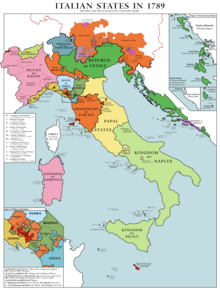
Back Invasió francesa de Venècia Catalan Caída de la República de Venecia Spanish Chute de la république de Venise French Caduta della Repubblica di Venezia Italian Queda da República de Veneza Portuguese Падение Венецианской республики Russian
This article includes a list of general references, but it lacks sufficient corresponding inline citations. (July 2018) |

The Republic of Venice was dissolved and dismembered by the French general Napoleon Bonaparte and the Habsburg Monarchy on 12 May 1797.
In 1796, the young general Napoleon had been sent by the newly formed French Republic to confront Austria, as part of the French Revolutionary Wars. He chose to go through Venice, which was officially neutral. Reluctantly, the Venetians allowed the formidable French army to enter their country so that it might confront Austria. However, the French covertly began supporting Jacobin revolutionaries within Venice, and the Venetian senate began quiet preparations for war. The Venetian armed forces were depleted and hardly a match for the battle-tested French or even a local uprising. After the capture of Mantua on 2 February 1797, the French dropped any pretext and overtly called for revolution among the territories of Venice. By 13 March, there was open revolt, with Brescia and Bergamo breaking away. However, pro-Venetian sentiment remained high, and France was forced to reveal its true goals after it provided military support to the underperforming revolutionaries.
On 25 April, Napoleon openly threatened to declare war on Venice unless it democratised. The Venetian Senate acceded to numerous demands, but facing increasing rebellion and the threat of foreign invasion, it abdicated in favor of a transitional government of Jacobins (and thus the French). On 12 May, Ludovico Manin, the last doge of Venice, formally abolished the Most Serene Republic of Venice after 1,100 years of existence.
The French and the Austrians had secretly agreed on 17 April in the Treaty of Leoben that in exchange for providing Venice to Austria, France would receive Austria's holdings in the Netherlands. France provided an opportunity for the population to vote on accepting the now public terms of the treaty that yielded them to Austria. On 28 October, Venice voted to accept the terms. The preference for Austria over France was well founded: the French proceeded to thoroughly loot Venice. They further stole or sank the entire Venetian Navy and destroyed much of the Venetian Arsenal, a humiliating end for what had once been one of the most powerful navies in Europe.
On 18 January 1798, the Austrians took control of Venice and ended the plunder. Austria's control was short-lived, however, as Venice would be back under French control by 1805. It then returned to Austrian hands in 1815 as the Kingdom of Lombardy–Venetia until its incorporation into the Kingdom of Italy in 1866.
© MMXXIII Rich X Search. We shall prevail. All rights reserved. Rich X Search